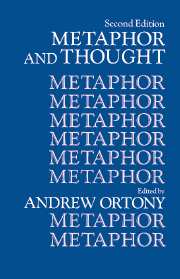Book contents
- Frontmatter
- Contents
- List of contributors
- Preface to the second edition
- Preface to the first edition
- 1 Metaphor, language, and thought
- METAPHOR AND MEANING
- METAPHOR AND REPRESENTATION
- METAPHOR AND UNDERSTANDING
- METAPHOR AND SCIENCE
- 20 The shift from metaphor to analogy in Western science
- 21 Metaphor and theory change: What is “metaphor” a metaphor for?
- 22 Metaphor in science
- 23 Metaphorical imprecision and the “top-down” research strategy
- METAPHOR AND EDUCATION
- References
- Author index
- Subject index
20 - The shift from metaphor to analogy in Western science
Published online by Cambridge University Press: 05 June 2012
- Frontmatter
- Contents
- List of contributors
- Preface to the second edition
- Preface to the first edition
- 1 Metaphor, language, and thought
- METAPHOR AND MEANING
- METAPHOR AND REPRESENTATION
- METAPHOR AND UNDERSTANDING
- METAPHOR AND SCIENCE
- 20 The shift from metaphor to analogy in Western science
- 21 Metaphor and theory change: What is “metaphor” a metaphor for?
- 22 Metaphor in science
- 23 Metaphorical imprecision and the “top-down” research strategy
- METAPHOR AND EDUCATION
- References
- Author index
- Subject index
Summary
Analogy and metaphor are central to scientific thought. They figure in discovery, as in Rutherford's analogy of the solar system for the atom or Faraday's use of lines of magnetized iron filings to reason about electric fields (Nersessian, 1984; Tweney, 1983). They are also used in teaching: novices are told to think of electricity as analogous to water flowing through pipes (Gentner & Gentner, 1983) or of a chemical process as analogous to a ball rolling down a hill (Van Lehn & J. S. Brown, 1980). Yet for all its usefulness, analogical thinking is never formally taught to us. We seem to think of it as a natural human skill, and of its use in science as a straightforward extension of its use in commonsense reasoning. For example, William James believed that “men, taken historically, reason by analogy long before they have learned to reason by abstract characters” (James, 1890, vol. II, p. 363). All this points to an appealing intuition: that a faculty for analogical reasoning is an innate part of human cognition, and that the concept of a sound, inferentially useful analogy is universal.
In this essay we question this intuition. We analyze the way in which analogy and metaphor have been used at different points in the history of Western scientific thought, tracing their use backward from the present time. We begin by laying out the current framework for analogical reasoning, followed by two examples that conform to the modern aesthetic, those of Sadi Carnot (1796–1832) and Robert Boyle (1627–1691).
Information
- Type
- Chapter
- Information
- Metaphor and Thought , pp. 447 - 480Publisher: Cambridge University PressPrint publication year: 1993
Accessibility standard: Unknown
- 120
- Cited by
